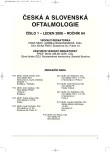Comparison of Contact and Immersion Techniques of Ultrasound Biometry
Authors:
J. Hřebcová; A. Vašků 1
Authors‘ workplace:
Klinika nemocí očních a optometrie LF MU a FN u sv. Anny, Brno, přednosta doc. MUDr. S. Synek, CSc.
; Ústav patologické fyziologie LF MU, Brno, vedoucí prof. MUDr. A. Vašků, CSc.
1
Published in:
Čes. a slov. Oftal., 64, 2008, No. 1, p. 16-18
Overview
Biometry, i. e. the measurement of the eye axial length, is performed in patients before cataract surgery. Together with keratometry, it serves for the calculation of the intraocular lens refractive (dioptric) power. The purpose of our study was to determine whether contact and immersion A-scan ultrasound techniques produce comparable measurements of the eye axial length. The axial length of 120 non-paired eyes was measured, using both contact and immersion techniques. The measurements were performed by means of an Alcon Ocuscan machine. The mean eye axial length using the contact technique was 23.28 mm (min. 19.31 mm, max. 31.25 mm), compared to the mean of 23.38 mm (min. 19.38 mm, max. 31.36 mm) gained by the immersion technique. The standard deviation of the measurements using both techniques was less than 0.1 mm. A statistically significant difference was proved between the contact and the immersion techniques (p < 0.01). There is significant correlation between both methods (p < 0.01). The eye axial length gained by means of the immersion technique was on average 0.1 mm longer than that obtained by the contact technique.
Biometry is of great importance for achieving accurate postoperative target refraction in cataract surgery that is a part of refractive surgery today. It will be necessary to carry out another retrospective study with a special focus on the target postoperative refraction in order to verify the accuracy of both the biometric techniques.
Key words:
ultrasound biometry, axial length measurement, contact technique, immersion technique, intraocular lens refractive power
Sources
1. Byrne, S.T, Green, R.L. : Ultrasound of the eye and orbit, USA, Mosby – an imprint of Elsevier Science, 2002, 505 s.
2. Giers, U., Apple, C.: Comparison of A-scan device accuracy, J. Cataract Refract. Surg., 16, 1990 : 235-342
3. Olsen, T.: Sources of error in intraocular lens power calculation, J. Cataract Refract. Surg., 18, 1992 : 125-129
4. Olsen, T., Nielsen, P.J.: Immersion versus contact technique in the measurement of axial length by ultrasound, Acta Ophthalmol., 67, 1989 : 101-102
5. Schelenz, J., Kammann, J.: Comparison of contact and immersion techniques for axial length measurement and implant power calculation, J. Cataract Refract. Surg., 15,1989 : 425-428
6. Skorkovská, Š., Michálek, J., Ruberová, M. et al.: Srovnání ultrazvukové a optické biometrie s ohledem na refrakci očí po operaci katarakty., Čes. a Slov.Oftal., 60, 2004, 1 : 24-29
7. Shammas, H.J.: A comparison of immersion and contact techniques for axial length measurement, Am.Intra-Ocular Implant Soc.J., 10, 1984 : 444-447
8. Retzlaff, J.A., Sanders, D.R, Kraff, M.C.: Development of the SRK/T intraocular lens implant power calculation formula, J. Cataract Refract. Surg., 16,1990 : 333-340
9. Waldon, R.G.: Immersion Biometry: It is not a water bath anymore, Abstrakta 3/2006, ASCRS, San Francisco
10. Wallace, R.B.: Refractive Cataract Surgery and Multifocal IOLs, USA, SLACK Incorporated, 2001, 243 s.
11. Watson, A., Armstrong, R.: Contact or immersion technique for axial length measurement? Australian and New Zealand J. Ophthalmol., 27,1999 : 49-51
Labels
OphthalmologyArticle was published in
Czech and Slovak Ophthalmology

2008 Issue 1
Most read in this issue
- Sarcoidosis – a Case Report
- Malignant Melanoma of the Uvea in the Department of Ophthalmology, Faculty Hospital Brno Bohunice, Czech Republic, EU
- Comparison of Contact and Immersion Techniques of Ultrasound Biometry
- Primary Vitrectomy with Intravitreal Antibiotic Application in Postoperative and Posttraumatic Endophthalmitis
